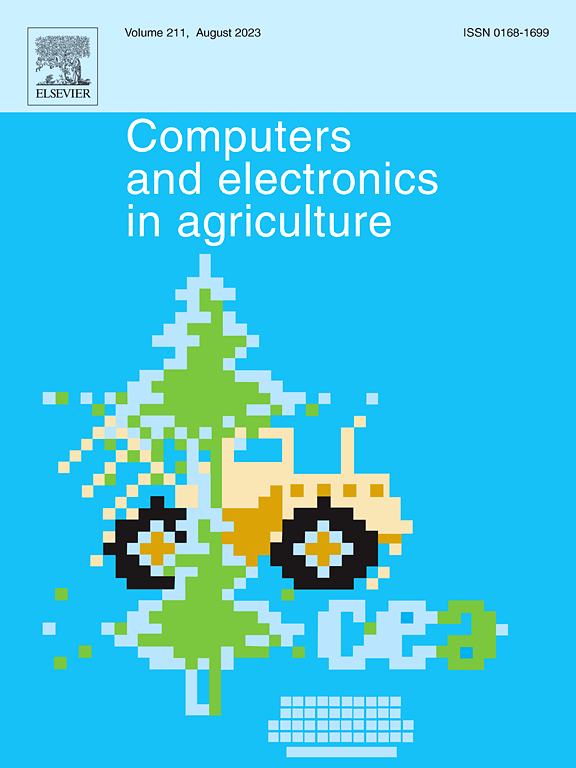基于多传感器数据融合的联合收割机吞吐量估计
IF 8.9
1区 农林科学
Q1 AGRICULTURE, MULTIDISCIPLINARY
引用次数: 0
摘要
产量是联合收割机运行性能和效率的关键指标。针对吞吐量监测系统体系结构不完善、对运行参数监测不足等导致吞吐量估计模型难以达到较高精度的问题,提出了一种基于多传感器数据融合的吞吐量估计方法。首先,开发了联合收割机多传感器数据监测与采集系统,实现了对进料、脱粒、行程、发动机等多传感器参数的在线监测与采集。其次,提出了一种基于PCA-WOA-SVR的多传感器融合估计模型。主成分分析(PCA)首先去除冗余和弱相关特征进行降维,然后使用支持向量回归(SVR)对减少的输入进行吞吐量估计,然后使用Whale优化算法(WOA)对SVR超参数进行优化,以获得最优的估计性能。最后进行了现场测试,结果表明该系统在各种工况下都具有较高的鲁棒性。测试集PCA-WOA-SVR的MAE为0.258 kg/s。R2、MSE、RMSE和MAPE分别为0.985、0.099、0.315和5.3%,具有较高的估计精度和较强的泛化能力。消融研究结果表明,与单独使用SVR相比,PCA-WOA-SVR的MAE降低了0.367 kg/s, R2提高了6.7%,MSE、RMSE和MAPE分别降低了0.434、0.415和7.4%,表明WOA和PCA有效地提高了SVR模型的估计性能。不同机组组合输入的估计结果表明,随着输入机组数量的增加,模型估计效果逐渐提高,其中发动机机组贡献最大。现场在线监测MAE为0.29 kg/s,在线监测数据连续波动范围在[−0.02,0.015]以内,单组监测时间为24.31 ms,满足在线监测精度、稳定性和实时性要求。综上所述,本文提出的吞吐量估计方法具有良好的鲁棒性、估计精度和泛化能力,为联合收割机吞吐量在线监测与反馈控制提供了重要的技术支持。本文章由计算机程序翻译,如有差异,请以英文原文为准。

Estimation of combine harvester throughput using multisensor data fusion
Throughput is a key indicator of a combine harvester’s operating performance and efficiency. In response to the challenge that throughput estimation models often struggle to achieve high accuracy due to the imperfect architecture of throughput monitoring systems and the insufficient monitoring on operational parameters, a multi-sensor data fusion-based throughput estimation method is proposed. Firstly, a multi-sensor data monitoring and acquisition system for combine harvester was developed to enable online monitoring and the acquisition of multi-sensor parameters from feeding, threshing, travel, and engine units. Secondly, a multi-sensor fusion estimation model based on PCA-WOA-SVR was introduced. Principal component analysis (PCA) first removes redundant and weakly correlated features to reduce dimensionality, then Support Vector Regression (SVR) estimates throughput from the reduced inputs, and Whale Optimization Algorithm (WOA) optimizes the SVR hyperparameters for optimal estimation performance. Finally, field tests were conducted, and the results showed that the system demonstrated high robustness under varying operating conditions. The MAE of PCA-WOA-SVR in the test set was 0.258 kg/s. The R2, MSE, RMSE and MAPE were 0.985, 0.099, 0.315, and 5.3 % respectively, showing high estimation accuracy and strong generalization ability. The ablation study results show that the MAE of PCA-WOA-SVR is reduced by 0.367 kg/s, R2 is increased by 6.7 %, MSE, RMSE and MAPE are reduced by 0.434, 0.415 and 7.4 %, respectively, compared to using SVR alone, demonstrating that WOA and PCA effectively enhance the estimation performance of the SVR model. The estimation results of different unit combination inputs show that as the number of input units increases, the model estimation effect gradually improves, among which the engine unit contributes the most. The MAE of field online monitoring is 0.29 kg/s, the continuous fluctuation range of the online monitoring data is within [−0.02, 0.015], and the single group monitoring time is 24.31 ms, which meets the requirements of online monitoring accuracy, stability and real-time performance. In summary, the throughput estimation method proposed in this study has good robustness, estimation accuracy and generalization ability, providing important technical support for the online monitoring and feedback control of the throughput for combine harvesters.
求助全文
通过发布文献求助,成功后即可免费获取论文全文。
去求助
来源期刊

Computers and Electronics in Agriculture
工程技术-计算机:跨学科应用
CiteScore
15.30
自引率
14.50%
发文量
800
审稿时长
62 days
期刊介绍:
Computers and Electronics in Agriculture provides international coverage of advancements in computer hardware, software, electronic instrumentation, and control systems applied to agricultural challenges. Encompassing agronomy, horticulture, forestry, aquaculture, and animal farming, the journal publishes original papers, reviews, and applications notes. It explores the use of computers and electronics in plant or animal agricultural production, covering topics like agricultural soils, water, pests, controlled environments, and waste. The scope extends to on-farm post-harvest operations and relevant technologies, including artificial intelligence, sensors, machine vision, robotics, networking, and simulation modeling. Its companion journal, Smart Agricultural Technology, continues the focus on smart applications in production agriculture.
 求助内容:
求助内容: 应助结果提醒方式:
应助结果提醒方式:


